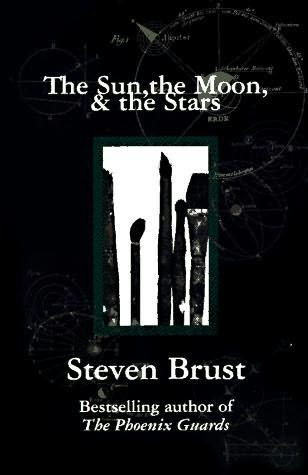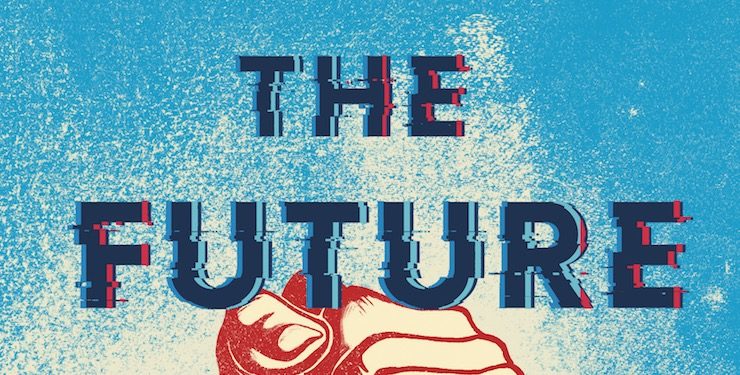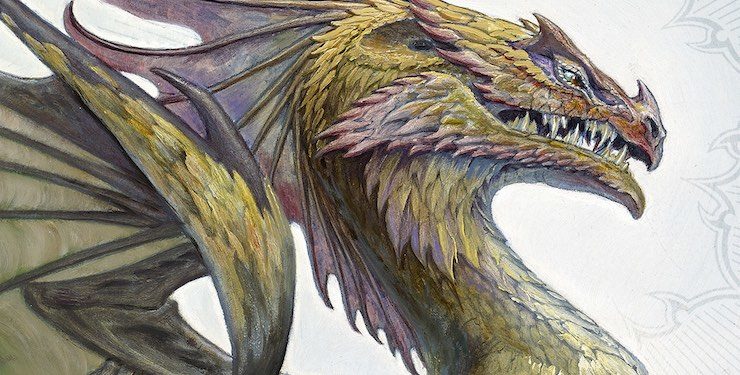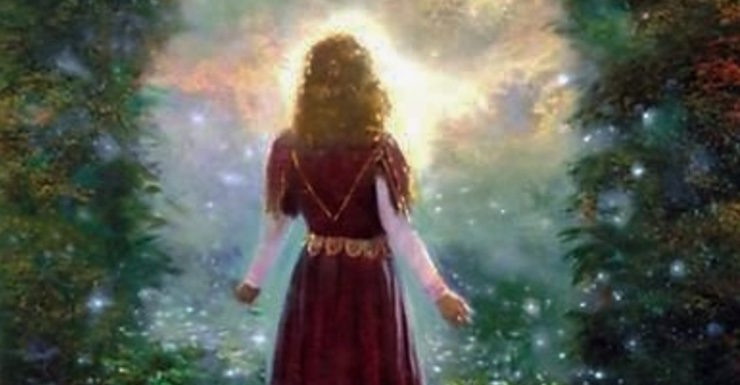The Sun the Moon and the Stars is not what you might expect of a fairytale retelling. Indeed, when it was originally published in Terri Windling’s excellent series of fantasy retellings of classic tales, with a long introduction about what fairytales are and a brief afterword about the Hungarian folk tradition, I imagine it must have been utterly baffling. You’d expect something straightforward like Patricia Wrede’s Snow White and Rose Red, or Charles de Lint’s Jack the Giant Killer, and instead this. It’s the story of a man painting a picture, and at the same time telling, in traditional form, a traditional Hungarian fairytale. It isn’t a fantasy novel at all—it’s a perfectly mainstream novel about a guy painting a picture and telling a story. There’s no fantasy element outside the story. And there’s no direct connection between the story he tells—which is likely to be completely new to most readers—and the other events of the book. It’s literally a fairytale retelling, someone retelling a fairytale, and it’s all told as a fairytale, with the narrator asking “bones?”, meaning “have you had enough yet?” at the end of each chapter, but it really isn’t what people would have been likely to expect.
What makes it brilliant is the way that it’s about the process of creation. Greg Kovacs, a painter, starts to paint in oils on a huge canvas, and as he goes on he discovers what he’s painting and talks about his process. Also he chats and squabbles with the other artists who share a studio with him, considers getting honest work as a draftsman, and decides to put on a show. Considered as plot, it isn’t one, but it’s utterly astonishing all the same because it talks about the way art is made in exactly the kind of way nothing else does—and woven in and out of it is the Hungarian fairytale of a Taltos who tricks and defeats monsters to steal the sun the moon and the stars and put them into the sky. He talks about painting, but it applies to any process of creation, certainly writing. If you want to know how writers actually write, either so you can do it yourself or just out of curiosity, I can’t think of anything better. It’s a book I often re-read near the beginning of starting a project, just to encourage myself.
There are some parallels between the fairytale Greg tells and the rest of the novel. First, the painting is of Apollo and Artemis killing Uranus, and it took me much longer than it should have to see that they are the sun the moon and the stars. Also, the fairytale is about doing something that should be impossible—and some bits of it are unexpectedly easy and other bits unexpectedly difficult, just like the process. There aren’t any exact parallels, and certainly not between the section of the fairytale in each chapter and the events of that chapter, but the loose parallels are there.
The interactions between Greg and the other members of the studio are what gives the book momentum and raises questions you want to see answered—will they survive as a group, will they have a show, will Greg finish his picture? They’re very real people, and Greg’s relationship with them changes, and affects everything else. I really like the way they criticize each other’s work, this is another part of the process of creation you rarely see written about. Brust describes something real here, and when he talks about technique and serendipity, something that you won’t find in books about how to write.
I also like the fact that Greg’s girlfriend, Debbie, is there and supportive throughout the book. You can ask yourself if he deserves her, but they have a romantic relationship that’s steady and doesn’t change. Brust also does this in Jhereg. It’s surprisingly rare for a book not to have a romance subplot—either the hero falls in love or falls out of love and finds new love. I find it really refreshing and unusual to read something that doesn’t have this kind of movement, but an assumed ongoing love. The emotional movement of The Sun the Moon and the Stars is all revolving around creation and art.
The thing that appeals to me least, after multiple re-readings, is the thing that made me pick the book up in the first place—the retelling of the Hungarian fairytale. I don’t skip it, because I keep thinking I’m missing something in it and I’ll eventually figure it out, but I care about the rest of it a lot more. It doesn’t have resonance for me, and the rest of it really does.
I know from previous discussions that some people love this book and others hate it, and it isn’t as simple as writers loving it and non-writers hating it. Both love and hate for it seems to be quite irrational and much stronger than you’d think. It’s a slim little book to inspire such passions. I love it, of course. I used to think that anyone who created art, of any form, would like it, but I now know it doesn’t work for everyone. But I still love it, and come back to it when I want to know that other people do this thing and make it work.
Bones?
Jo Walton is a science fiction and fantasy writer. She’s published eight novels, most recently Half a Crown and Lifelode, and two poetry collections. She reads a lot, and blogs about it here regularly. She comes from Wales but lives in Montreal where the food and books are more varied.















Soup.
(Though I think I remember the response in that book is “tiles,” not “soup,” isn’t it.)
It’s been a while since I read that one. It isn’t my favorite of the Fairy Tales series, nor my favorite of Brust’s books, but it’s a good one nonetheless.
Aeeifica: It is indeed “tiles”. But “soup” made me laugh, and seemed very appropriate– Tolkien’s soup of story, not to mention stone soup.
I admit I couldn’t remember what the response was, so I Googled with terms like “hungarian storytelling bones” until I found “soup.” (Other groups cited used “bricks” or “meat” as the response.)
You made me really curious about this book. I am Hungarian and I’ve never read it. For some reason Steven Brust is not really appreciated in Hungary. It’s a complicated matter but the gist of it, I think, is that when they published the only book of his that actually appeared in Hungarian, Brokedown Palace, they overlooked the fact that being Hungarian isn’t exactly exotic in Hungary and treated certain words and names as they did in the English version, italicizing and misspelling them… which felt a lot like reading “Hari Pota was a wizard and he had glasses” would to an English speaker.
I find it very interesting that the fairytale didn’t have resonance for you, though it is true that Hungarian tales are somewhat different from Western tales. I’m really curious about the tale itself (that “dragon with eight heads” is a key phrase on Amazon isn’t exactly a good sign; dragons have 3, 7 or 9 heads, but never eight) but unless it is a really very liberal adaptation, I think I would find it very familiar.
I will definitely order the book after my next pay day, so thank you for bringing it up!
Tapsi: There are dragons with eight, ten, and twelve heads, so clearly a more even-headed tradition. I’d be absolutely fascinated to know what you think of it, because you’d be coming to it with a context that I’m completely lacking. Please do report back.
Brokedown Palace was the first Brust I read, and it completely confused me. It’s not like any of his other books. I should read it again.
(Incidentally, the Hungarian cover for Farthing is my absolute favourite.)
I know the girl who did that cover, she’s a wonderful person and she’s very talented. She lives with the man who translated Farthing, so in a way that book was a family matter for them. I know they both loved it.
I will definitely report back when I’ve read the book, I’m really curious now, but it will take a few weeks for the book to wing its way here…
Tiles. I love this book in much the same way you do, but I missed the bit about the gods in the painting being the sun, moon, and stars. Though of course the whole thing is about sacrifices and creation. The fairy tale itself is also my least favorite bit; I keep waiting for it to fall into the pattern. Maybe a couple more rereads.
Oddly, I just read an actual oil painting textbook that was about more general processes in much the same way as the Brust. It almost felt like a companion piece.
For a complicated and not very interesting set of reasons, I ended up hidden in the corner of a painting studio in college where the advanced students were working. And I ended up staying curled up back there after my task was done, longer than I intended, because they were talking *just like* _The Sun, the Moon, and the Stars_, and I found it fascinating.
I like Kate Wilhelm’s mysteries in part because so few of them have a new romance as the central relationship. They have an old, established romance, or they have a familial relationship, or like that. It’s refreshing.
I visit this site for several reasons, but key are your book reviews. With so many books published each year — in and out of the genre, fiction and non-fiction — the peril exists that we lose our catalog (in publisher parlance).
I recall (I hope correctly!) your review of Bob Silverberg’s singularly magisterial, DYING INSIDE… and now your review of Steve Brust’s THE SUN, THE MOON, AND THE STARS.
I agree with your implicit point: that Brust’s novel is sui generis. Who am I to make such a claim? Just another reader, but one trained to discern between the wheat and the chaff. Really, I never did get why Steve struggles so mightily to achieve success (as measured by book sales, income, etc) when his auctorial talents, his genius, are well beyond the crowd.
But mine is not to reason why. I buy Steve’s non-fantasy novels in bulk, and thrust them into other people’s hands. I figure that sooner or later, they will pick up THE SUN, THE MOON, AND THE STARS, among other books, and give it a try. And THE SUN, THE MOON, AND THE STARS is an easy sell: name another novel that begins so compellingly.
Thank you.
David@10: Wait, Steven’s non-fantasy novels? There’s this one. And then there’s…um…I guess Cowboy Feng, and possibly Freedom and Necessity. But those last two have fairly clear non-realistic elements.
I think this may still be my choice for “best” in Steven’s work. I should read it again; I don’t think I’ve ever actually reread it.
DD-B — I think David may have meant Brust’s non-Dragaeran novels?
David M. Gordon @@@@@ 10, I’ll take your challenge! The following novels all start with lines I find more compelling than this one. (Which is not to say I don’t like this book–this is only about the opening.)
“to wound the autumnal city.”
– Dhalgren, Samuel Delany
“The year Janet started at Blackstock College, the Office of Residential Life had spent the summer removing from all the dormitories the old wooden bookcases that, once filled with books, fell over unless wedged. Chase and Phillips’ A New Introduction to Greek was the favorite instrument for wedging; majors in the Classics used the remedial math textbook, but this caused the cases to develop a slight backward tilt, so that doughnuts, pens, student identification cards, or concert tickets placed on top of them slid with indistinguishable slowness backward and eventually vanished dustily behind.”
(OK, with this one I wanted to include another sentence or two, but I stopped myself because it was getting long already.)
Tam Lin, Pamela Dean
“If I had been armed on horseback, I could have taken them all out. Even afoot I could have made a good showing with a sword.”
The King’s Peace, by our hostess
“It was a dumb thing to do but it wasn’t that dumb. There hadn’t been any trouble out at the lake in years.”
Sunshine, Robin McKinley
Thank you for the save, Jo.
Yes, David, I mean Steve’s “non-Dragaeran” novels. To THE SUN, THE MOON, AND THE STARS, I would add FREEDOM AND NECESSITY (which you noted), A REIGN IN HELL, and AGYAR. Possibly also GYPSY, although I have yet to read that novel. I realize each of those novels has its own idiosyncratic fantastical elements, but they are not truly fantasy. Well, with the arguable exception of AGYAR.
And what an exception. With apologies to Jo (this is your forum, not mine), I would like to show why Steve should be revered as a supreme stylist, genre author or no. Apart from the transliteration of the title, AGYAR, nothing in the novel tells the reader it is a vampire tale. Well it does, but obliquely. For example…
I recall… how Mrs. Lockwitt’s earring dangled against her neck and reflected light from a fixture of four frosted sixty-watt bulbs.
Please tell me what normal guy notices these things? Why the fixation on her neck? (Oh, right.) And how the heck could anyone look at 4 60 watt bulbs (240 watts!) while they are on and read the teeny letters (and from a distance of –)?
Steve provides these subtle hints repeatedly throughout the novel. Added to the mix are the even more obtuse clues…
I’ve heard women, and, lately, some men, talk of women acting stupid to please men, but in fact, I think, that is not what they are doing; it is not lack of wit or intellect that shallow men crave, it is lack of personality; they desire a woman who will exist only as a shadow to themselves, because this gives them the illusion that they have some importance, that they are more than cattle (emboldening mine — dmg). Personality is what distinguishes us from each other, what makes each man and woman unique, and to submerge one’s personality is to make one’s self interchangeable, like a mass-produced commodity; yet the demands of instinct, the will to survive through reproduction, are strong, and if this is what it takes to fulfill that instinct, not many can fight it…
Please name another vampire novel that shrouds its author’s social commentary behind the scrim of an oblique clue as to the true nature of the protagonist.
aedifica, I did not limit my challenge to compelling openings to genre, but all literature. An excellent argument can be made for Dickens’s A TALE OF TWO CITIES, of course, in addition to your fine examples. But here’s the thing: an opening sentence, even the first paragraph could be brilliant (Dickens), intelligent, clever, or even haunting (your Delaney example), but not necessarily compelling. Leave off the author’s name and the reader’s pre-disposition, and you are left with the author’s talent at using 26 letters and a few punctuation marks to compel you to continue to read on past his or her opening. How does it get better than,
You want to know what good is? I’ll tell you what good is.
Now, don’t you just want to keep reading…? Perhaps find out just what “good” is, and why it is important, and…
Thank you, Jo, for allowing me the opportunity to caterwaul on your venue.
David: This space is for conversation, and your contribution is very welcome.
It’s hard to talk about Agyar without spoilers. If you say “There’s this great book, and it never says overtly what it’s about!” people immediately ask “And what is it about?”
I’ve always been out at the far, far end of the “love it” scale for the very brilliance you cite. Your review brings to my attention that “creativity” and “creation” are further apart in my brain than they have any cause to be. The book doesn’t just talk about the creative process; it doesn’t just show it in the tale. It illuminates creativity from its very core, the core where the writer…a color-blind writer at that…turns to completely different genre of art — painting — to explore the creative process.
And that’s why I turned to yet another art form — sculpture — to thank Steve and demonstrate how much I liked his book. (A black & white photo of “The Sun, the Moon, and the Stars” by sculptor David Pelto is on the inside back cover of the trade paperback of Steve’s book.) Then again, I kept the sculpture for myself rather than having it installed in his yard. It was a gift of knowledge and appreciation to Steve; the gift of the sculpture itself was one I gave myself.
Steve knew I’d commissioned a sculpture, but not its title or that it had anything to do with him or his book. I threw a big party, and asked Steve to drum at the unveiling. That wasn’t just to ensure he was there, or that he met the sculptor. It was to layer on yet another form of creativity, of creation, in continued celebration of the book and everything it so successfully does. Well, for this reader, at least.
I rarely re-read any fiction, but your review leaves me wanting to re-read The Sun, the Moon, and the Stars. Thank you.
I love this book. I made my mom read it (she’s an artist). I want to say something else about how much I love this book, but I just can’t come up with anything more than: I really love this book.
By the way,
THIS MAY BE A BIT OF A SPOILER FOR AYGAR
the problems with Aygar as regards to spoilers, is a bit like the problem with Some of Your Blood, and until this comment thread, the similarities between the books had not struck me. They both read just as well (but differently) when you know and when you don’t.
Kitryan and David: I’ve been reading Agyar over the weekend and am now having great difficulty writing about it. Expect a post soon!
Your review, Jo, offers a splendid location to share this news:
http://www.heraldleaderphoto.com/2008/09/18/man-decorates-basement-with-10-worth-of-sharpie/
A far cry from the work executed by the protagonist’s roommate (in Chapter 1), but still visually exciting.
I only hope you see this post, and its link.
Best wishes!
David: That is awesome, and so very appropriate to The Sun, the Moon, and the Stars. Thank you for posting it.